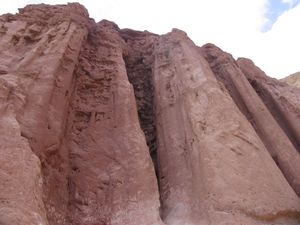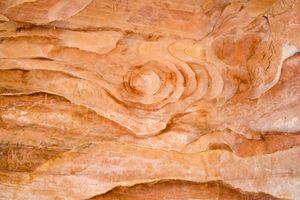الحجر الرملي النوبي
الحجر الرملي النوبي Nubian Sandstone، يشير إلى مجموعة متنوعة من الصخور الرسوبية الموجودة في قاعدة ترجع إلى ما قبل الكامبري في شرق الصحراء الكبرى، شمال شرق أفريقيا وشبه الجزيرة العربية. ويتكون من أحجار رملية قارية بداخلها طبقة رقيقة من الأحجار الجيرية البحرية، والمارل. ترسب الحجر الرملي النوبي بين نهاية حقبة الحياة القديمة وبداية العصر الطباشيري، مع تكون ودائع بحرية ترجع إلى ما بين العصر الفحمي ونهاية العصر الطباشيري.[1]
التشكل
تشكل الحجر الرملي النوبي فيما بين العصر الكمبري والطباشيري. Positioning of the paleoequator and paleolatitude عند درجة حرارة 20° س was derived from paleomagnetic data توضح أن الحجر الرملي النوبي تشكل في الأصل في المنطقة الاستوائية الحجرية حتى المنطقة شبه الإستوائية. These paleomagnetic results corroborated previous studies suggesting there was no polar wandering and continental drift in Africa during 210 to 110 million years and extended this period to 85 million years. Nubian sandstone is deposited under a tropical to subtropical climate and is formed under a variety of continental conditions, excluding eolian merging intermittently into shallow marine.[2]
الخصائص
لتجمع الحجر الرملي النوبي سماكة تتراوح من أقل من 500 م إلى أكثر من 3000 م، مستقرة على قاعدة ما قبل الكمبري. This is complicated by various structural faults and fold axes traversing the region in a north-eastern direction. Maximum development occurs in the Ain Dalla basin, a downthrown structural block south-west of the Bahariya oasis. Basement features present a dominant control on the complex's structural and sedimentological form. Despite many structural complications, Nubian sandstone likely constitutes a single hydrogeological system west of the Suez Gulf. To the east, on the Sinai peninsula, a second system might exist with some connection to the primary western system in the north. The main western system, extending into Libya and Sudan, consists of a multi-layered artesian basin where massive groundwater reserves accumulated, principally during pluvials of the Quaternary. Locally, carbonate rocks overlying the complex display karst features and are recharged by upwards leaks from the underlying major aquifer.[3] Fluvial and structural interpretations from 2007 show the desert in western Egypt was induced by fluvial action, including recently mapped alluvial fans. In central areas, braided channels are spatially aligned to a north-east structural trend, suggesting preferential water flow paths. Alluvial fans and structurally enclosed channels coincided to gentle slopes and optimal recharge conditions between 1 and 5%, indicating high groundwater potential. Synthetic Aperture Radar (SAR) interpretations correlated with anomalies from groundwater in 383 wells, suggesting a connection between the spatial organization of fluvial and structural features with low-salinity groundwater, which exists adjacent to alluvial fans and the south-west reaches of structurally enclosed channels. Wells in the vicinity of structures contained low-salinity water.[4]
التربة الناتجة
Nubian sandstone exposures in sub-humid, semi-arid, and arid conditions produce soil that is red-sandy but very different in other aspects. Only in sub-humid zones do these soils contain a moderately developed profile, including a textural B horizon lacking soluble salts and carbonates. In semi-arid and arid zones, profile differentiation is either weak or does not exist. In arid zones soils are shallow and contain carbonates, and soluble salts, including gypsum. The sole clay common to all Nubian sandstone parent materials is Kaolinite, which is the major clay mineral in sub-humid zone soil. In semi-arid soils smectite is a second major clay component. In arid zones small amounts of smectite and palygorskite accompany kaolinite. It is likely that smectite and palygorskite are products of pedogenic neoformation. Aeolian material was probably introduced into the silt and fine sand fractions from semi-arid and arid soils. It is also possible that some contamination of clay fractions occurred.[5]
الحجر الرملي النوبي في شبه الجزيرة العربية
When in contact with Upper Cretaceous limestone, Nubian sandstone underlies the latter conformably. In Lebanon, Anti-Lebanon and Hermon it is underlaid by Jurassic limestone. Its upper strata is likely from the Lower or Middle Cretaceous age. However, Jurassic limestone is absent in southern areas. In Western Sinai, Nubian sandstone rests on Carboniferous limestone, and by the Dead Sea on Cambrian limestone: at Petra and other locations it rests unconformably on Crystalline rocks. While age calculation for Nubian sandstone is relatively simple in Lebanon, Anti-Lebanon and Hermon, it is much more complicated in Western Sinai and the Dead Sea. Since sandstone is assumed to form more rapidly than other rocks it is difficult to conceive that the 2,000 feet of sandstone in the southeastern Dead Sea was in the formative process from the Cambrian to the Cretaceous.
المظهر
الحجر الرملي النوبي يتميز بلونه البني أو البني المائل للأحمر، لكن يوجد أحجار أخرى بدرجات لونية مختلفة. المعابد والأضرحة القديمة في البتراء والتي كانت قد شكلت من هذا الحجر. في أماكن معينة يكون هشاً للغاية، وفي أماكن أخرى يكون مضغوط وصلب. الرمال الموجودة في الصحاري العربية تشكلت بصورة رئيسية من هذا الحجر، والتي حملتها الرياح الغربية السائدة. ولأنه مغطى بطبقة من الصخور البركانية، فهو محمي من التعرية. يتضمن الحجر الرملي النوبي على طبقات من الطين والطفل الصفحي وطبقات رقيقة من الفحم أو الليگنايت. يشير هذا إلى أن الحجر الرملي النوبي قد ترسب في بحار كانت ضحلة نسبياً في ذلك الوقت.
التسمية
طُرح مصطلح "الحجر الرملي النوبي" لأول مرة على علم التراصف المصري من قبل جوسف روسگر عام 1837، الذي استخدم مصطلح "Sandstein von Nubien" للإشارة إلى الحجر الرملي اللا أحفوري داخل قطاعات من حقبة الحياة القديمة أو الحقبة الوسطى. قام روسگر بمتابعة ودراسة سلسلة من تشكيلات الحجر الرملي من السودان، مصر، ليبيا وArabia Petrsea.[6]
انظر أيضاً
- نظام الحجر الرملي النوبي للمياه الجوفية
- الدرع العربي النوبي
- Sedimentary rock
- درع
- الراسخ
- رصيف
- قاعدة
- قاعدة منصة
الهوامش
المصادر
- B. Issawi, Review of Upper Cretaceous-Lower Tertiary Stratigraphy in central and southern Egypt. - American Association of Petrol. Geol. Bull., Vol. 56 No.8, 1973
- El Shazly, Atomic Energy Establishment, Egypt 1982
- A.A. Shata, Hydrogeology of the Great Nubian Sandstone Basin Desert Research Institute, Egypt 1982
- Tate, Ralph, On the Age of the Nubian Sandstone: Quarterly Journal of the Geological Society (1871); Vol. 27 No. 1-2
- Essay and Maps: Groundwater Resources of the Nubian Aquifer System
- El Sayed. A Study of Hydrogeological Conditions of the Nubian Sandstone Aguifer in the Area between Abu Simbel & Toschka, Western Desert, Egypt American Geophysical Union 2001
- A.C. Seward: Leaves of Dicotyledons from Nubian sandstone of Egypt, Geological Survey, 1935.
- El-Baz and El-Shazly, The Nubian Aquifer in Southwest Egypt: Hydrogeology Journal, Vol. 15 No. 1, 2007
- Paleogeography & Paleomagnetism of the Nubian Sandstone Eastern Desert of Egypt: in the International Journal of Earth Sciences. Vol. 62, No. 1. 1973 ISSN:1437-3254
- International Atomic Energy Agency: NSAS Project
- A. Singer, Characteristics of Nubian Sandstone - Derived Soils European Journal of Soil Science 1974

